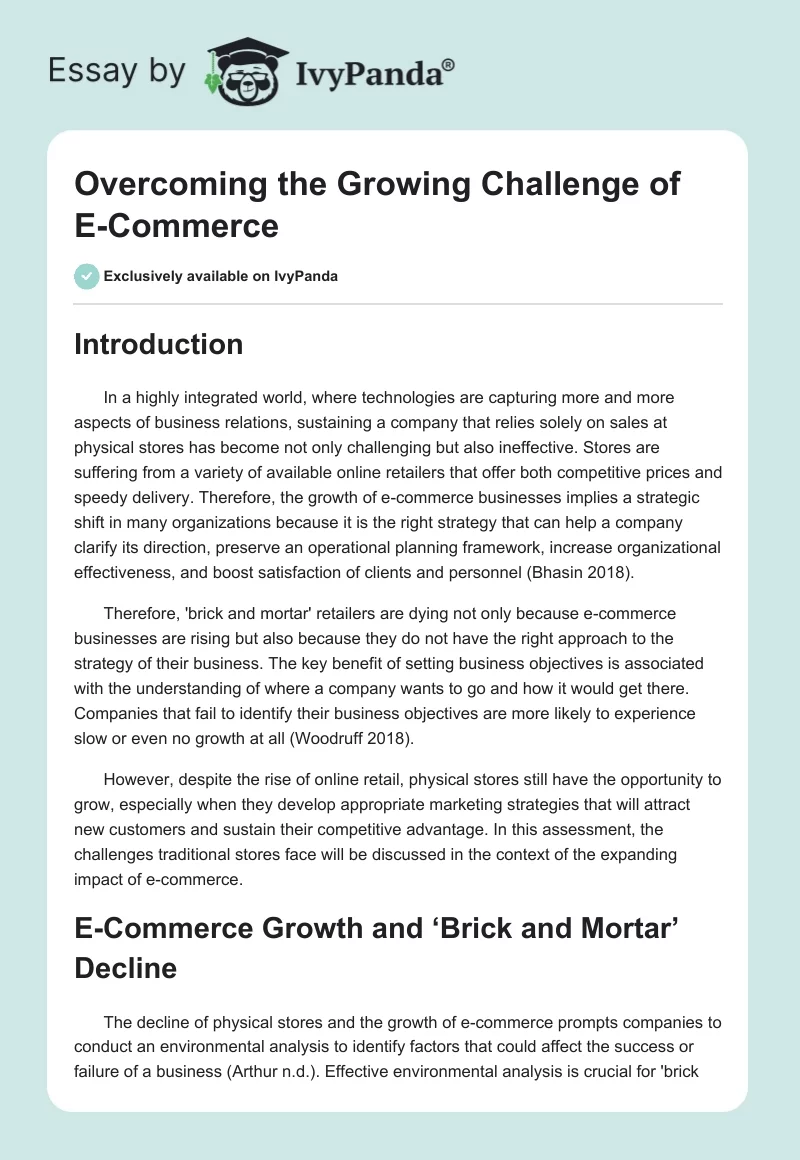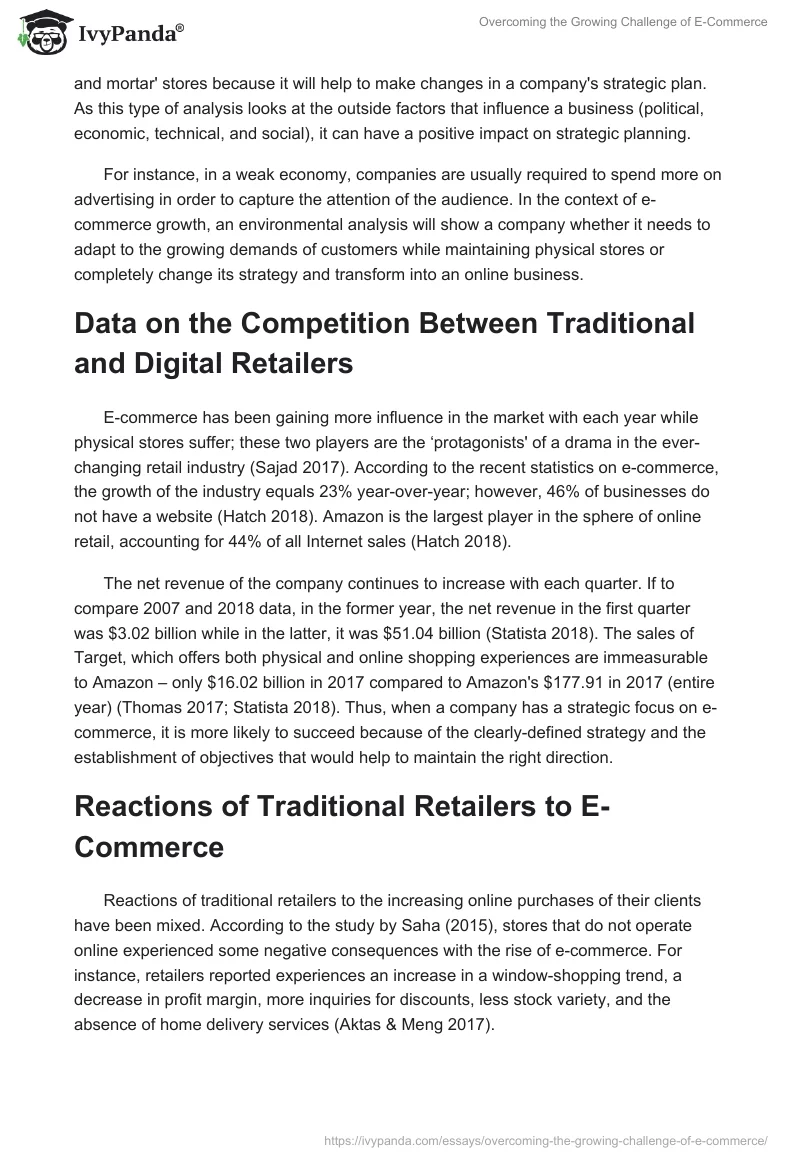Introduction
In a highly integrated world, where technologies are capturing more and more aspects of business relations, sustaining a company that relies solely on sales at physical stores has become not only challenging but also ineffective. Stores are suffering from a variety of available online retailers that offer both competitive prices and speedy delivery. Therefore, the growth of e-commerce businesses implies a strategic shift in many organizations because it is the right strategy that can help a company clarify its direction, preserve an operational planning framework, increase organizational effectiveness, and boost satisfaction of clients and personnel (Bhasin 2018).
Therefore, ‘brick and mortar’ retailers are dying not only because e-commerce businesses are rising but also because they do not have the right approach to the strategy of their business. The key benefit of setting business objectives is associated with the understanding of where a company wants to go and how it would get there. Companies that fail to identify their business objectives are more likely to experience slow or even no growth at all (Woodruff 2018).
However, despite the rise of online retail, physical stores still have the opportunity to grow, especially when they develop appropriate marketing strategies that will attract new customers and sustain their competitive advantage. In this assessment, the challenges traditional stores face will be discussed in the context of the expanding impact of e-commerce.
E-Commerce Growth and ‘Brick and Mortar’ Decline
The decline of physical stores and the growth of e-commerce prompts companies to conduct an environmental analysis to identify factors that could affect the success or failure of a business (Arthur n.d.). Effective environmental analysis is crucial for ‘brick and mortar’ stores because it will help to make changes in a company’s strategic plan. As this type of analysis looks at the outside factors that influence a business (political, economic, technical, and social), it can have a positive impact on strategic planning.
For instance, in a weak economy, companies are usually required to spend more on advertising in order to capture the attention of the audience. In the context of e-commerce growth, an environmental analysis will show a company whether it needs to adapt to the growing demands of customers while maintaining physical stores or completely change its strategy and transform into an online business.
Data on the Competition Between Traditional and Digital Retailers
E-commerce has been gaining more influence in the market with each year while physical stores suffer; these two players are the ‘protagonists’ of a drama in the ever-changing retail industry (Sajad 2017). According to the recent statistics on e-commerce, the growth of the industry equals 23% year-over-year; however, 46% of businesses do not have a website (Hatch 2018). Amazon is the largest player in the sphere of online retail, accounting for 44% of all Internet sales (Hatch 2018).
The net revenue of the company continues to increase with each quarter. If to compare 2007 and 2018 data, in the former year, the net revenue in the first quarter was $3.02 billion while in the latter, it was $51.04 billion (Statista 2018). The sales of Target, which offers both physical and online shopping experiences are immeasurable to Amazon – only $16.02 billion in 2017 compared to Amazon’s $177.91 in 2017 (entire year) (Thomas 2017; Statista 2018). Thus, when a company has a strategic focus on e-commerce, it is more likely to succeed because of the clearly-defined strategy and the establishment of objectives that would help to maintain the right direction.
Reactions of Traditional Retailers to E-Commerce
Reactions of traditional retailers to the increasing online purchases of their clients have been mixed. According to the study by Saha (2015), stores that do not operate online experienced some negative consequences with the rise of e-commerce. For instance, retailers reported experiences an increase in a window-shopping trend, a decrease in profit margin, more inquiries for discounts, less stock variety, and the absence of home delivery services (Aktas & Meng 2017).
The report shows that retailers lack the understanding of how they should address the shifting needs of their customers while staying competitive against e-commerce companies (Morgan 2017). Therefore, companies are forced to make significant strategic shifts in how they operate their businesses to address changing consumer trends. With Amazon capturing a variety of sectors, from clothing to technologies, traditional retailers usually do not know how to respond (Gjerstad & Papp 2017).
In terms of strategic decisions, they may invest into creating a new online store and offering deliveries; however, because they cannot cut costs when sustaining the supply chain to physical stores, they are less likely to offer prices that can be comparable to those offered by solely e-commerce businesses. Specific strategic decisions that can make the difference include the improvement of value proposition and the enhancement of customer experiences.
Both of these options will ensure that customers are satisfied with the quality and value of products brought by physical stores and choose them over e-commerce businesses. In addition to attracting customers, in an organizational setting, the mentioned strategic decisions are expected to boost competitive advantage and foster a positive outlook of companies on their future in retail.
The Future of the Retail Industry
The future of retail is likely to imply digital transformation as the increased variation of products that consumers can buy. On both sides of the world, there are regular reports of high street workers losing their jobs due to the accelerated shift from physical shopping toward the use of technologies. Importantly, e-commerce is soon expected to transform into m-commerce, which means that customers will make purchases using their mobile devices (McLellan 2018).
The theory of strategic change applies in this case, and according to Drucker, includes four forces such as globalization, knowledge capital, new technologies, and cultural pluralism (What is strategic change n.d.). The model of strategic change thus implies that companies should not make decisions about their future based on existing knowledge. Rather, drivers of change and strategizing based on the mentioned forces is the key for companies to succeed in an ever-changing environment. While strategic change is hard to control or predict, there are still aspects that will point to whether a company achieved success or not.
Thus, the future of the retail industry will depend on the prioritization of strategies that allow to the bringing of value to clients, the training of personnel who can adapt to the changing environment, understanding of the existing competition, and the management of inventory (Leinbach-Reyhle 2014).
Recommendations for Traditional Retailers
Competing against e-commerce giants such an Amazon is the key strategic advantage barrier that many ‘brick and mortar’ stores face. In this case, marketing becomes the greatest tool in the hands of companies as it can bring new customers to stores (Kumar & Reinartz 2018). First, within their marketing campaigns, physical stores should emphasize that they provide the same services as online stores: speed and convenience.
These two factors play a significant role in making customers choose online stores over physical ones (Nicasio 2018). Attractive features can include same-day delivery, mobile apps, discounts for buying in-store, and so on. Second, in the case when a physical store is located in a shopping centre, it may be a good solution to communicate with other shops and restaurants to develop a marketing strategy that will attract customers to that specific location.
For instance, Nebraska Crossing Outlets (NEX) saw a $15 million in expansion within a year because of the collaboration between different businesses to create promotions. When a store was not reaching its monthly sales goal, it asked the help of the NEX marketing manager who would develop instant offers and attract customers (Nicasio 2018). Third, physical stores must be unique enough and go beyond commodities that any other shop or online store will offer.
Stocking locally produced items will bring more interest because that cannot be found or bought anywhere else. An example of this is what Sugarfina (a candy store is Pasadena), which lets their clients create personalized bento boxes with sweets. Clients can choose their own sizes, designs, and select a variety of candies that they like, which is an experience that is unique to that specific store. Fourth, stores should learn how to be more considerate when setting competitive pricing because online retailers can offer lower prices to customers since they do not need to sustain physical locations (BPP Learning Media 2016).
Cutting costs through automation and the optimization of resources’ use has been extremely important for e-commerce businesses. In order for retailers to be competitive, they should work with their vendors to lower the costs of goods as well and create customization offers that will target specific customers based on their shopping behaviours.
Conclusion
To conclude, the increased use of technologies in retail business points to the fact that the values of customers have shifted in the direction of low costs, convenience, accessibility, and quick delivery. As large online stores such as Amazon have become marketplaces for customers to buy anything they want and get it delivered fast, physical stores suffer from the increase of window-shopping and the decrease of interest in what they have to offer. Nevertheless, there is still a place for ‘brick and mortar’ stores in the retail industry in cases when they offer customers unique products and experiences that cannot be replicated anywhere else.
Marketing becomes the key tool for physical retailers to achieve success because they will need to attract customers by using advertising tactics. Examples of successful advertising include the collaboration between stores at the NEX mall, which creates special offers to potential customers and uses the value proposition of multiple stores to drive new clients to their location. Overall, it can be concluded that despite the rise of e-commerce, physical stores can still survive and even thrive. The key thing is for them to understand the ways in which they can offer competitive prices, create value, and be unique in what they do.
Reference List
Aktas, E & Meng, Y 2017, ‘An exploration of Big Data practices in retail sector’, Logistics, vol. 1, no. 12, pp. 1-28.
Arthur, L n.d., The implications of environmental analysis on strategic plan. Web.
Bhasin, H 2018, Role of strategy. Web.
BPP Learning Media 2016, CIMA E3 strategic management, BPP House, London.
Hatch, C 2018, Be in the know: 2018 e-commerce statistics you should know. Web.
Kumar, V & Reinartz, W 2018, Customer relationship management: Concept, strategy, and tools, Springer, Berlin.
Leinbach-Reyhle, N 2014, ‘Five habits of successful retailers’, Forbes. Web.
McLellan, C 2018, ‘The future of retail: 2018 and beyond’, Zdnet. Web.
Morgan, B 2017, ‘Five trends shaping the future of customer experience in 2018’, Forbes. Web.
Nicasio, F 2018, How to compare with Amazon: 7 tips for brick-and-mortar stores, weblog. Web.
Saha, A 2015, ‘A study on the impact of online shopping upon retail trade business’, Journal of Business and Management, vol. 2015, pp. 74-78.
Sajad, R 2017, Apps management and e-commerce transactions in real-time, IGI Global, Hershey.
Statista 2018, Net revenue of Amazon from 1st quarter 2007 to 3rd quarter 2018 (in billion U.S. dollars). Web.
Thomas, L 2017, ‘Target shows progress, but turnaround still has a way to go’, CNBC. Web.
What is strategic change n.d. Web.
Woodruff, J 2018, The importance of setting business objectives. Web.


